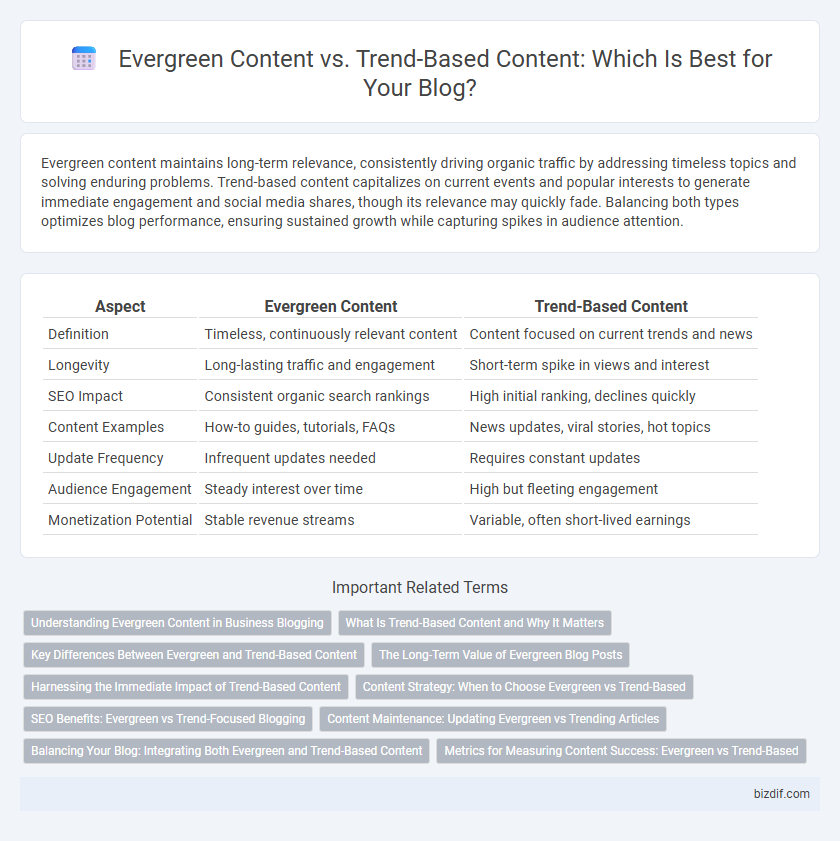Evergreen content maintains long-term relevance, consistently driving organic traffic by addressing timeless topics and solving enduring problems. Trend-based content capitalizes on current events and popular interests to generate immediate engagement and social media shares, though its relevance may quickly fade. Balancing both types optimizes blog performance, ensuring sustained growth while capturing spikes in audience attention.
Table of Comparison
| Aspect | Evergreen Content | Trend-Based Content |
|---|---|---|
| Definition | Timeless, continuously relevant content | Content focused on current trends and news |
| Longevity | Long-lasting traffic and engagement | Short-term spike in views and interest |
| SEO Impact | Consistent organic search rankings | High initial ranking, declines quickly |
| Content Examples | How-to guides, tutorials, FAQs | News updates, viral stories, hot topics |
| Update Frequency | Infrequent updates needed | Requires constant updates |
| Audience Engagement | Steady interest over time | High but fleeting engagement |
| Monetization Potential | Stable revenue streams | Variable, often short-lived earnings |
Understanding Evergreen Content in Business Blogging
Evergreen content in business blogging refers to articles or posts that remain relevant and valuable to readers over long periods, providing consistent traffic and engagement. Unlike trend-based content, evergreen topics address fundamental questions, problems, or interests within a niche, such as how-to guides, tutorials, or industry best practices. This type of content enhances SEO by continuously attracting organic search traffic and establishing authority within the market.
What Is Trend-Based Content and Why It Matters
Trend-based content captures current topics, news, or viral phenomena with high search volume and social media engagement over a short period. This type of content drives immediate traffic, boosts visibility, and leverages timely interest to attract a broader audience. Marketers prioritize trend-based content to capitalize on real-time relevance and enhance brand responsiveness to shifting consumer interests.
Key Differences Between Evergreen and Trend-Based Content
Evergreen content remains relevant over time, consistently attracting traffic with topics such as how-to guides, tutorials, and industry fundamentals. Trend-based content captures immediate interest by focusing on current events, viral topics, or seasonal trends, leading to spikes in engagement but short-lived relevance. Understanding these differences helps in balancing a content strategy for sustained growth and timely audience engagement.
The Long-Term Value of Evergreen Blog Posts
Evergreen blog posts provide consistent, long-term value by remaining relevant and useful to readers regardless of trends or time. These posts generate steady organic traffic and improve search engine rankings over months or years, unlike trend-based content which experiences fleeting spikes in interest. Investing in evergreen content creates a sustainable foundation for ongoing audience growth and brand authority.
Harnessing the Immediate Impact of Trend-Based Content
Trend-based content captures audience attention rapidly by tapping into current events and viral topics, driving immediate spikes in traffic and engagement. Quick publication and strategic use of trending keywords maximize visibility across social media platforms and search engines. Leveraging real-time analytics helps refine content performance, ensuring timely adjustments to sustain momentum.
Content Strategy: When to Choose Evergreen vs Trend-Based
Evergreen content offers long-term value by addressing timeless topics that consistently attract traffic, making it ideal for building a stable content foundation and improving SEO over time. Trend-based content capitalizes on current events or viral topics, driving immediate spikes in engagement and increasing social shares but requiring timely updates to maintain relevance. A balanced content strategy integrates evergreen and trend-based posts, using data analytics to identify optimal publishing times and audience preferences for maximizing reach and sustained growth.
SEO Benefits: Evergreen vs Trend-Focused Blogging
Evergreen content consistently attracts organic traffic by addressing timeless topics and providing lasting value, making it a cornerstone for sustainable SEO growth. Trend-based content generates immediate spikes in visibility and engagement by capitalizing on current events or viral topics but often experiences rapid decline in relevance and ranking. Balancing evergreen articles with targeted trend-focused posts enhances overall SEO strategy, boosting long-term authority while capturing timely audience interest.
Content Maintenance: Updating Evergreen vs Trending Articles
Evergreen content requires periodic updates to maintain accuracy and relevance, ensuring sustained traffic and search engine ranking over time. Trend-based content demands frequent revisions or timely removal to capitalize on fleeting interest and avoid obsolescence. Effective content maintenance strategies prioritize evergreen articles for long-term value while selectively refreshing trending posts to maximize engagement during their peak.
Balancing Your Blog: Integrating Both Evergreen and Trend-Based Content
Balancing your blog by integrating both evergreen content and trend-based content enhances long-term audience engagement and drives immediate traffic spikes. Evergreen content, such as how-to guides and foundational industry insights, maintains relevance and consistently attracts visitors over time. Trend-based content capitalizes on current events and popular topics, boosting short-term visibility and fostering timely interactions.
Metrics for Measuring Content Success: Evergreen vs Trend-Based
Evergreen content consistently drives organic traffic over time, measured by metrics such as steady page views, sustained user engagement, and long-term search engine rankings. Trend-based content experiences rapid spikes in metrics like social shares, short-term page views, and immediate engagement, but typically sees a quick decline after the trend fades. Analyzing bounce rates, average session duration, and conversion rates can help determine the ongoing value and relevance of both content types.
Evergreen Content vs Trend-Based Content Infographic

 bizdif.com
bizdif.com